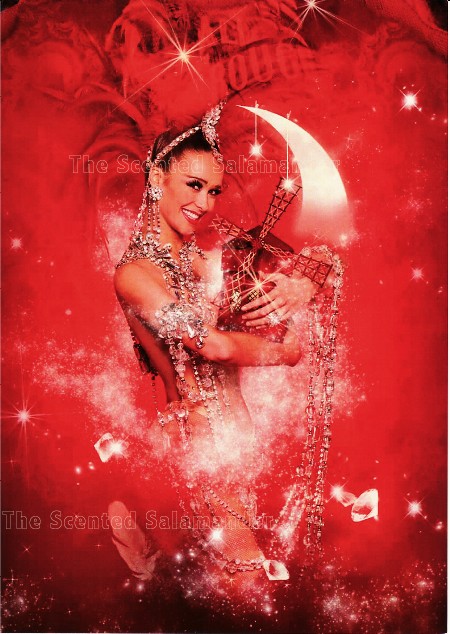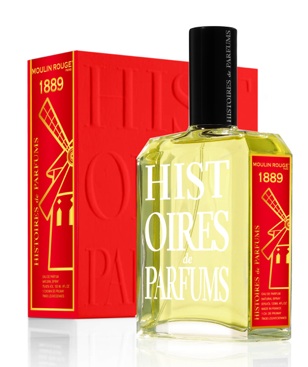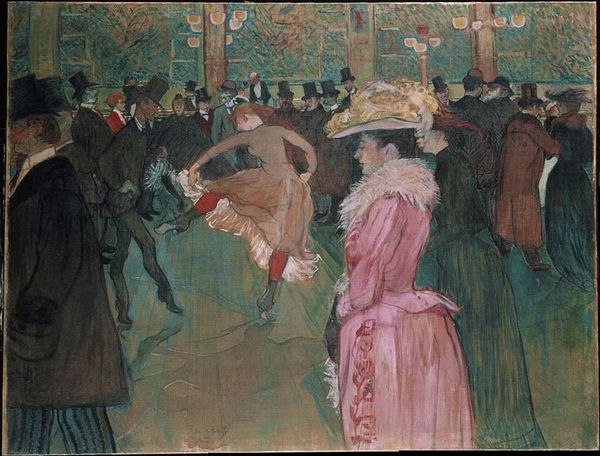Histoires de Parfums Moulin Rouge 1889 (2009): Impressions, Scent Notes, Stories: A Demonstration of Its Ineffability? {Perfume Review}

The new Moulin Rouge 1889 by Histoires de Parfums is named after the famous Parisian cabaret, the birth place of French Can Can, and the date of its establishment. 1889 is also in the history of Western perfumery the year of birth of Jicky by Guerlain considered to be the first full-fledged modern fragrance composition.
The Eau de Parfum co-signed by art director Gérald Ghislain and perfumer Fabrice Olivieri of TrendsLab was commissioned to celebrate the 120th anniversary of the cabaret and was launched together with an inaugural line of Moulin-Rouge accessories for the body and home which also includes jewelry, feather lamps, shoes. The scent is inspired by the atmosphere of the dance-hall today but also reportedly by the figure of painter Toulouse-Lautrec (1864-1901) who immortalized the 19th century honk-a-tonk and its dancers. Rather than devote attention to the historical context here, I will focus on the somewhat elusive, hard-to-pin-down quality of the perfume, a refreshing departure in an universe encumbered by copy-cat perfumes and overly cautious launches.
Around Moulin Rouge 1889: Impressions, Scent Notes, Stories: A Demonstration of Its Ineffability?
I can imagine a coterie of people linked by a creed in a common body of convictions whose central tenet would be that the best perfumes are recognizable due to their ineffable quality. If you cannot talk about them or if you fail to present a coherent, one-piece story of the scent, then it means that this perfume is stronger than words, that it is really what it is supposed to be: its own language, perfume.
This is to some extent the problem I am encountering with Moulin Rouge 1889 by Histoires de Parfums....
I can tell you about my first impression, quite vivid of the scent, the story it told me, in fragments. But then the story dissolves at the second take. When I turn to the press materials it is not clarification I find but further confusion and a sense of kindred spirit in the temptation to multiply the personalities of the scent. Why? Because I happen to have two official stories of the scent and to make matters even more resistant to discursive logic, each version not only tells a different narrative but offers different perfume notes.
I have found that usually what this all means is that the perfume contains all these different stories, sources of inspiration and notes. Why would the communications department of the brand send out such differing statements is another question to which I can only find a partial answer. We know that many if not most perfumer-composers are weary of words and of reductionist explanations. What they are most interested in is to see people wear their fragrances, live with them, invest them with their own emotions and life experiences. So in a way one could say that this is what they are entitled to doing themselves. It is a way of affirming that the materiality of a scent is secondary, that it could be pulled this or that way. Yet not all perfumes succeed in achieving the quality of elusiveness, of being beyond immediate and clear analysis. In fact, another coterie would probably be keen on insisting that a perfume ought to reveal structure, an architecture that is well-recognizable and defined.
Would perfumes that achieve the quality of ineffability be more wearer-oriented than creator-oriented? In a sense, yes. They leave a deeper and larger space for daydreaming. If perfumes are not just deodorizing objects as some may still think but canvases of floating ideas that are nebulous enough to make room for our own personal dreams to be painted our own particular shades of colors then they become that part of mystery that many of us who are not religious need in our lives. The interesting thing about Moulin Rouge is that it is both dreamy, vague and clearly bearing the imprint of a reflection, that of its creator.
Moulin Rouge thus officially does not want to be just one thing. I personally perceive it differently each time and so have decided to present this problem while proposing my first reading of it. I have found that looking at the perfume notes afterwards was no help at all as it breaks somewhat the mystery and charm of the perfume. Where the mandarin added an understated, hard-to-define understated syrupiness, it suddenly jumps out of the composition to smell of just of mandarin.There are perfumes that are meant to be elucidated and become perhaps more interesting thanks to that effort and others that lose their spellbinding charm when you start seeing through them. I would propose that Moulin Rouge is best left alone with its ineffable quality than broken down into the units that make up its illusion. Just like seeing a rare color be analyzed may be destructive. But in a way, it is already too late for me.
I don't know if this is a strength or a weakness of the composition; it is probably both.
The Scent
Moulin Rouge is offered as a "velvety chypre."
First of all what strikes me is what I interpret as a carnation - iris accord which might actually be the effect described by the official cinnamon note that I personally perceive as such only later. What it means is that there is some spicy Eugenol molecule in the composition. At first, the scent is floral, like an unusual spicy carnation and iris blend. Smelling the perfume I would classify it most certainly as a full-blown iris composition.
The unexpected feedback I get from a previous Italian announcement I re-read now is that rose is listed here but not iris. This floral note is however - checking another document - listed in the French press materials I received as "coeur d'iris", heart of iris. The rose from Damas (heart notes) is wrapped in the all-embracing folds of the iris (base notes), not the contrary, and reappears only much later in the lingering sensation of a light rosy chypre.
Moulin Rouge does not start like the raising of a red curtain at all or like the ambiance you might have expected of a cleaned up festive red bordello atmosphere. It is dream-like, very iris-y and reminds me of the adulated Iris Gris by Jacques Fath as like it, it smells both fresh, chamois-like and a bit fruity. I would go as far as saying that it is so far of the fragrances I've smelled the one that reminds me most of the original Iris Gris. It is very soft and bready, slippering into gray-pearl satin mules quickly. Aldehydes are perceptible but not too pronounced. It is also sweetened by an orange-y facet and a seemingly transparent, diaphanous amber.
The composition seems to want to leave its mark as a particularly lovely iris perfume, with a desirable classic, bland doughy quality referencing a time when iris butter was more accessible. At some point rather than feeling you are smelling face powder or lipstick which use the iris note quite a bit in their formulae, it feels like you are smelling edible flour atop kneaded dough. It's a very soft, very moony impression nevertheless suggesting paleness and delicacy of complexion.
It turns out that Gérald Ghislain wanted to actually suggest the "flavor" of lipstick - women de facto ingest it - rather than its scent and I still think that it smells more like buttery iris and a bread-in-the-making than lipstick. As Histoires de Parfums puts it,
"The lipstick exhale its powdery flavor, the champagne glasses clink and the mandarin sparkles."
Then there seems to be a discreet whiff of cinnamon, almost bubblegum-y but always folded into this pale doughy sensation. The spiciness becomes more insistent, more like Red-Hots, underlined by a dash of mouthwatering black pepper in salty-sweet cream. I need to make a dessert out of this sensation, is the thought which crosses my mind after a few takes.
A prune note was inserted to suggest the roundness of shoulders of the dancers and their golden skins. That part reminds me a bit of Jean-Charles Brosseau Fleurs d'Ombre Bleue with its solar and nostalgic powdery note layered with dark prune, but mostly in terms of ideas, not so much on the level of sensation.
After a while the ideal iris accord gives way to a more abstract opulent flower that is hard to decipher but smells almost venomous. This is where the reds (cinnamon), the celebrated raunchiness of Moulin Rouge seem to kick in after the evocation of a distinguished and pale Belle Epoque atmosphere.
The creator explains that he wanted to contrast the feminine scents of a boudoir with that of a masculine leather (cf. Italian press materials.)
I thought I smelled leather but it is a leather that is so profoundly floral that it smells more like an unknown exotic flower that is ominously seductive and alluring thanks to its sightly putrid charm. The flower is carnal in a meaty sense almost. I personally love just the right hint of the scents of decay and putridity.
The poisonous sensation must come from the absinthe accord anchored by a slightly head-shop-y patchouli, which may hint or may not hint at the cheap scents worn by cocottes. This passage although not smelling of tuberose per se, has the intensity of tuberose.
The drydown is powdery with a hint of bitterness from the absinthe. It has a certain lift to it, which might justify its descriptive as a chypre. This impression is confirmed later on by a more marked rosy and pruny chypré effect. The prune also lends it a slightly sweet-and-sour facet.
Moulin Rouge for me has the "Wow! Factor" in it. It is original, out of the ordinary, complex, creative, and makes you want to wear it for its uniqueness. It creates a succession of very different atmospheres and scenes, like a good spectacle.
It could have smelled like L'Heure Bleue or Après L'Ondée by Guerlain; it does not. It could have smelled like Douce Amère by Serge Lutens; it does not, again.
This is what so-called niche perfumery ought to be about: dedication to the search of unusual accords that you would be hard-pressed to find in more widely distributed perfumes. To use a movie-industry analogy, this scent reinstates my belief that there can be fragrances that can be classified under the heading "cinéma d'art et d'essai" to resort to the beautifully descriptive French expression for art films. If I wanted to translate this in its most literal form, I would say that it means a cinema of art and trial, here a perfumery of art and trial.
What one can appreciate also about this perfume is how despite the narrative motif itself, the Moulin Rouge cabaret with all its trappings which calls a priori for a certain boldness, the composition reveals a meditative quality, the reflection of the artist's mind at work, his vision.
It is lovely to be able to believe in the particular, silent language of perfumery thanks to such a fine composition.
Opening notes: mandarin, prune, cinnamon
Sustained notes: absinthe, rose from Damas
Lingering notes: heart of iris, patchouli, musk, fur
Source: French press release
Notes: rose, aldehydes, pepper, leather, musk, vanilla, amber.
Source: Italian press release
Available in a 100 ml spray bottle for 130€ and a Kit Nomade (travel kit) of 3 X 14 ml for 80€











Hi, where can i purchase 1889 moulin rouge (by histoires de parfums) in London U.K.?
Many thanks A.
Matches carry Histoires de Parfums in London. I don't see 1889 on their site but you can check with them: 44 020 7487 5400. It might be a Moulin Rouge boutique exclusive but you could also try to contact the brand via their website at histoiresdeparfums.com and ask if they'd accept to ship to the UK.